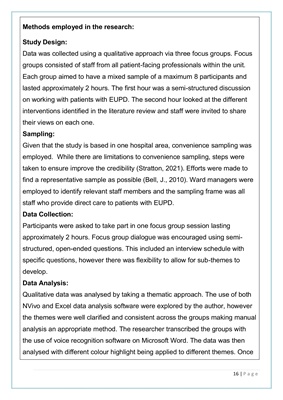
16 | P a g e
Methods employed in the research:
Study Design:
Data was collected using a qualitative approach via three focus groups. Focus
groups consisted of staff from all patient-facing professionals within the unit.
Each group aimed to have a mixed sample of a maximum 8 participants and
lasted approximately 2 hours. The first hour was a semi-structured discussion
on working with patients with EUPD. The second hour looked at the different
interventions identified in the literature review and staff were invited to share
their views on each one.
Sampling:
Given that the study is based in one hospital area, convenience sampling was
employed. While there are limitations to convenience sampling, steps were
taken to ensure improve the credibility (Stratton, 2021). Efforts were made to
find a representative sample as possible (Bell, J., 2010). Ward managers were
employed to identify relevant staff members and the sampling frame was all
staff who provide direct care to patients with EUPD.
Data Collection:
Participants were asked to take part in one focus group session lasting
approximately 2 hours. Focus group dialogue was encouraged using semistructured,
open-ended questions. This included an interview schedule with
specific questions, however there was flexibility to allow for sub-themes to
develop.
Data Analysis:
Qualitative data was analysed by taking a thematic approach. The use of both
NVivo and Excel data analysis software were explored by the author, however
the themes were well clarified and consistent across the groups making manual
analysis an appropriate method. The researcher transcribed the groups with
the use of voice recognition software on Microsoft Word. The data was then
analysed with different colour highlight being applied to different themes. Once